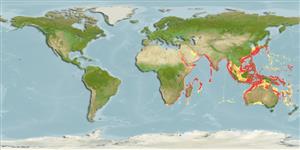Common names from other countries
分類 / Names
俗名 | 同種異名 | Catalog of Fishes(屬, 種) | ITIS | CoL | WoRMS | Cloffa
Teleostei >
Blenniiformes (Blennies)
鱸形目 (Blennies) >
Blenniidae (Combtooth blennies)
鳚科 (Combtooth blennies) > Blenniinae
Etymology: Xiphasia: Greek, xiphos = sword (Ref. 45335).
More on author: Swainson.
Environment: milieu / climate zone / depth range / distribution range
生態學
海洋 底中水層性; 深度上下限 2 - 1190 m (Ref. 40919). 熱帶
Indo-West Pacific: Red Sea and False Bay, South Africa to Vanuatu, north to southern Japan, south to Australia.
印度-西太平洋: 紅海與南非佛斯灣到萬那度, 北至日本南部, 南至澳洲。
大小 / 重量 / 年齡
Maturity: Lm ? range ? - ? cm
Max length : 53.0 cm SL 雄魚/尚未辨別雌雄; (Ref. 4404)
背棘 (總數) : 13 - 14; 背的軟條 (總數) : 105 - 119; 臀棘: 2; 臀鰭軟條: 107 - 119. Easily distinguished from other blennies by an extremely elongate body. Dorsal fin origin above eye.
容易地與其他黏魚區分了被一非常地細長的身體。 背鰭起點眼睛上方。
Adults occur on open soft-bottom and mud habitats from shallow bays to deep water. They are found in tube-like burrows in sand or mud bottoms (Ref. 9710). Very rarely encountered but more usually seen at night (Ref. 90102). Nocturnal feeders. Stomach of two specimens trawled in 50-54 m off western India contain crustaceans (including copepods), polychaete remains, forams, fish scales, and some sand and mud (Ref. 11441). Oviparous. Eggs are demersal and adhesive (Ref. 205), and are attached to the substrate via a filamentous, adhesive pad or pedestal (Ref. 94114). Larvae are planktonic, often found in shallow, coastal waters (Ref. 94114). Have eel-like bodies but are rarely seen swimming away from their burrow (Ref. 48636).
生活於開放的軟質底部與從淺灣到深水域的泥棲息地。 在沙或泥底部中發現於管狀洞穴了。 (參考文獻 9710) 夜行的捕食者。 二件標本的腹部在外海的印度西部包含甲殼動物 (包括橈腳類的動物) ,多毛類的殘餘物,有孔動物,魚鱗與一些沙子與泥的 50-54 公尺中拖網捕獲。 (參考文獻 11441) 卵生的.(參考文獻 205) 有像鰻魚一樣的身體但是被很少地調查游泳遠離他們的洞穴.(參考文獻 48636)
Life cycle and mating behavior
Maturities | 繁殖 | Spawnings | Egg(s) | Fecundities | 仔魚
Oviparous, distinct pairing (Ref. 205).印度-西太平洋: 紅海與南非佛斯灣到萬那度, 北至日本南部, 南至澳洲。
Randall, J.E., G.R. Allen and R.C. Steene, 1990. Fishes of the Great Barrier Reef and Coral Sea. University of Hawaii Press, Honolulu, Hawaii. 506 p. (Ref. 2334)
CITES (Ref. 128078)
Not Evaluated
人類使用
漁業: 商業性; 水族館: 商業性
工具
特別的報告
下載 XML
網路資源
Estimates based on models
Preferred temperature (Ref.
115969): 8 - 19.8, mean 12.4 (based on 836 cells).
Phylogenetic diversity index (Ref.
82804): PD
50 = 0.7500 [Uniqueness, from 0.5 = low to 2.0 = high].
Bayesian length-weight: a=0.00102 (0.00046 - 0.00225), b=3.06 (2.88 - 3.24), in cm Total Length, based on all LWR estimates for this body shape (Ref.
93245).
營養階層 (Ref.
69278): 3.9 ±0.5 se; based on size and trophs of closest relatives
回復力 (Ref.
120179): 中等的, 族群倍增時間最少 1.4 - 4.4年 (Assuming tm=1-3 and Fec=100-1000).
Fishing Vulnerability (Ref.
59153): Moderate to high vulnerability (46 of 100).
